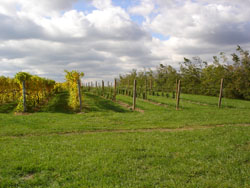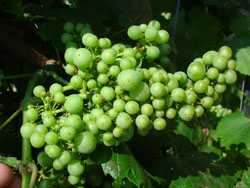Eric Stafne, Mississippi State University
Wind damage on grapevines. From top left, going clockwise. Broken shoots caused by wind (Oklahoma). Windbreak planted near vineyard (Virginia). Poor fruit set and berry fertilization due to high wind (Russian River, California). Trellis collapse due to wind (Texas). Photos by Fritz Westover, Texas AgriLife Extension, and Eric Stafne, Mississippi State University.
Wind damage is commonly seen in regions with strong prevailing winds or spring and summer thunderstorms. Fast growing vines and certain cultivars are more prone to wind damage. Damage to shoots is most common in spring and early summer when new shoots are fast growing and tender (green). Later in the season, after shoots have matured, leaf damage is more common. Heavy leaf damage can cause a reduction in photosynthesis that may impact fruit quality and vine cold hardiness.
Entire canes with leaves that begin to flag (wilt) among other healthy canes are an indication of wind damage. Flagging will lead to eventual browning and death of leaves. The damaged cane will die if it was broken at its connecting point on the cordon. This damage can be mistaken for disease, insect, or herbicide damage, but close inspection will reveal underlying cane breakage at the base of the cane. Wind damage can be reduced by controlling vine vigor and with proper canopy management.
In certain cases, trellis systems have been known to topple when oriented perpendicular to the direction of prevailing winds. Although uncommon, this situation can be avoided by orienting rows parallel to prevailing winds and/or by establishing windbreaks. Windbreaks can either be permanent (i.e., a tree row) or temporary (e.g., fabric or fencing that acts as a baffle); however, any wind barrier should not be close enough to cause excess shading, competition with vines, or allelopathic effects.
Constant winds can also cause damage to fruit, by creating callused or scabbed areas where fruit has been rubbed by another plant part. Fruit set and fertilization may also be affected if heavy and constant winds persist during flowering. This type of damage is more critical in freshly consumed products and may lead to a decrease in economic potential of the fruit.
Recommended Resources
Grapevine Problems: Leaf Spots Not Caused by Insects or Disease
Hail Damage to Vines and Fruit
Reviewed by Tim Martinson, Cornell University and Fritz Westover, Texas AgriLife Extension




